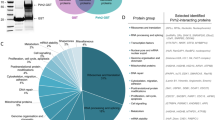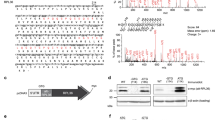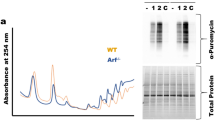Abstract
The p14ARF tumor suppressor is a key regulator of cellular proliferation, frequently inactivated in human cancer. The mechanisms that regulate alternative reading frame (ARF) turnover have been obscure for long time, being ARF a relatively stable protein. Recently, it has been described that its degradation depends, at least in part, on the proteasome and that it can be subjected to N-terminal ubiquitination. We have previously reported that ARF protein levels are regulated by TBP-1 (Tat-Binding Protein 1), a multifunctional protein, component of the regulatory subunit of the proteasome, involved in different cellular processes. Here we demonstrate that the stabilization effect exerted by TBP-1 requires an intact N-terminal 39 amino acids in ARF and occurs independently from N-terminal ubiquitination of the protein. Furthermore, we observed that ARF can be degraded in vitro by the 20S proteasome, in the absence of ubiquitination and this effect can be counteracted by TBP-1. These observations seem relevant in the comprehension of the regulation of ARF metabolism as, among the plethora of cellular ARF's interactors already identified, only NPM/B23 and TBP-1 appear to be involved in the control of ARF intracellular levels.
This is a preview of subscription content, access via your institution
Access options
Subscribe to this journal
Receive 50 print issues and online access
$259.00 per year
only $5.18 per issue
Buy this article
- Purchase on Springer Link
- Instant access to full article PDF
Prices may be subject to local taxes which are calculated during checkout






Similar content being viewed by others
References
Bertwistle D, Sugimoto M, Sherr CJ . (2004). Physical and functional interactions of the Arf tumor suppressor protein with nucleophosmin/B23. Mol Cell Biol 24: 985–996.
Bothner B, Lewis WS, DiGiammarino EL, Weber JD, Bothner SJ, Kriwacki RK . (2001). Defining the molecular basis of Arf and Hdm2 interactions. J Mol Biol 314: 263–277.
Chen Y, Sharp ZD, Lee WH . (1997). HEC binds to the seventh regulatory subunit of the 26 S proteasome and modulates the proteolysis of mitotic cyclins. J Biol Chem 272: 24081–24087.
Colombo E, Bonetti P, Lazzerini Denchi E, Martinelli P, Zamponi R et al. (2005). Nucleophosmin is required for DNA integrity and p19Arf protein stability. Mol Cell Biol 25: 8874–8886.
Colucci-D'Amato GL, D'Alessio A, Califano D, Calì G, Rizzo C, Nitsch L et al. (2000). Abrogation of nerve growth factor-induced terminal differentiation by ret oncogene involves perturbation of nuclear translocation of ERK. J Biol Chem 275: 19306–19314.
Corn PG, McDonald III R, Herman JG, El-Deiry WS . (2003). Tat-binding protein-1, a component of the 26S proteasome, contributes to the E3 ubiquitin ligase function of the von Hippel–Lindau protein. Nat Genet 35: 229–237.
Gallagher SJ, Kefford RF, Rizos H . (2006). The ARF tumor suppressor. Int J Biochem Cell Biol 38: 1637–1641.
Gonzalez F, Delahodde A, Kodadek T, Johnston SA . (2002). Enforced expression of p14ARF induces p53-dependent cell cycle arrest but not apoptosis. Science 296: 548–550.
Itahana K, Bhat KP, Jin A, Ithana Y, Hawke D, Kobayashi R et al. (2003). Tumor suppressor ARF degrades B23, a nucleolar protein involved in ribosome biogenesis and cell proliferation. Mol Cell 12: 1151–1164.
Kong X, Lin Z, Liang D, Fath D, Sang N, Caro J . (2006). Histone deacetylase inhibitors induce VHL and ubiquitin-independent proteasomal degradation of hypoxia-inducible factor 1alpha. Mol Cell Biol 26: 2019–2027.
Korgaonkar C, Hagen J, Tompkins V, Frazier AA, Allamargot C, Quelle FW et al. (2005). Nucleophosmin (B23) targets ARF to nucleoli and inhibits its function. Mol Cell Biol 25: 1258–1271.
Kuo ML, den Besten W, Bertwistle D, Roussel MF, Sherr CJ . (2004). N-terminal polyubiquitination and degradation of the Arf tumor suppressor. Genes and Dev 18: 1862–1874.
Lam YA, Lawson TG, Velayutham M, Zweier JL, Pickart CM . (2002). A proteasomal ATPase subunit recognizes the polyubiquitin degradation signal. Nature 416: 763–767.
Liu CW, Corboy MJ, DeMartino GN, Thomas PJ . (2003). Endoproteolytic activity of the proteasome. Science 299: 408–411.
Lohrum MA, Ashcroft M, Kubbutat MH, Vousden KH . (2000). Identification of a cryptic nucleolar-localization signal in MDM2. Curr Biol 10: 539–540.
Paliwal S, Pande S, Kovi RC, Sharpless NE, Bardeesy N, Grossman SR . (2006). Targeting of C-terminal binding protein (CtBP) by ARF results in p53-independent apoptosis. Mol Cell Biol 26: 2360–2372.
Park BW, O'Rourke DM, Wang Q, Davis JG, Post A, Qian X et al. (1999). Induction of the Tat-binding protein 1 gene accompanies the disabling of oncogenic erbB receptor tyrosine kinases. Proc Natl Acad Sci USA 96: 6434–6438.
Pollice A, Nasti V, Ronca R, Vivo M, Lo Iacono M, Calogero R et al. (2004). Functional and physical interaction of the human ARF tumor suppressor with Tat-binding Protein-1. J Biol Chem 279: 6345–6353.
Reef S, Zalckvar E, Shifman O, Bialik S, Sabanay H, Oren M et al. (2006). A short mitochondrial form of p19ARF induces autophagy and caspase-independent cell death. Mol Cell 22: 463–475.
Rodway H, Llanos S, Rowe J, Peters G . (2004). Stability of nucleolar versus non-nucleolar forms of human p14(ARF). Oncogene 23: 6186–6192.
Russell SJ, Reed SH, Huang W, Friedberg EC, Johnston SA . (1999). The 19S regulatory complex of the proteasome functions independently of proteolysis in nucleotide excision repair. Mol Cell 3: 687–695.
Sdek P, Ying H, Chang DL, Qiu W, Zheng H, Touitou R et al. (2005). MDM2 promotes proteasome-dependent ubiquitin-independent degradation of retinoblastoma protein. Mol Cell 20: 699–708.
Sharpless NE . (2004). Ink4a/Arf links senescence and aging. Exp Gerontol 39: 1751–1759.
Sharpless NE . (2005). INK4a/ARF: a multifunctional tumor suppressor locus. Mutat Res 576: 22–38.
Sherr CJ . (2001). The INK4a/ARF network in tumour suppression. Nat Rev Mol Cell Biol 2: 731–737.
Voges D, Zwickl P, Baumeister W . (1999). The 26S proteasome: a molecular machine designed for controlled proteolysis. Annu Rev Biochem 68: 1015–1068.
Weber JD, Kuo ML, Weber JD, Kuo ML, Bothner B, DiGiammarino EL et al. (2000). Cooperative signals governing ARF-mdm2 interaction and nucleolar localization of the complex. Mol and Cell Biol 20: 2517–2528.
Acknowledgements
We are grateful to B Majello and C Sherr for generously providing some plasmids used in this study. This work was supported by grants from Telethon (GGP030326), MIUR and AIRC to G La Mantia.
Author information
Authors and Affiliations
Corresponding author
Rights and permissions
About this article
Cite this article
Pollice, A., Sepe, M., Villella, V. et al. TBP-1 protects the human oncosuppressor p14ARF from proteasomal degradation. Oncogene 26, 5154–5162 (2007). https://doi.org/10.1038/sj.onc.1210313
Received:
Revised:
Accepted:
Published:
Issue Date:
DOI: https://doi.org/10.1038/sj.onc.1210313
Keywords
This article is cited by
-
PSMC3 promotes RNAi by maintaining AGO2 stability through USP14
Cellular & Molecular Biology Letters (2022)
-
PKC Dependent p14ARF Phosphorylation on Threonine 8 Drives Cell Proliferation
Scientific Reports (2018)
-
Bacterial expression strategies for several Sus scrofa diacylglycerol kinase alpha constructs: solubility challenges
Scientific Reports (2013)
-
A 19S proteasomal subunit cooperates with an ERK MAPK-regulated degron to regulate accumulation of Fra-1 in tumour cells
Oncogene (2012)
-
Rpt5
AfCS-Nature Molecule Pages (2007)



